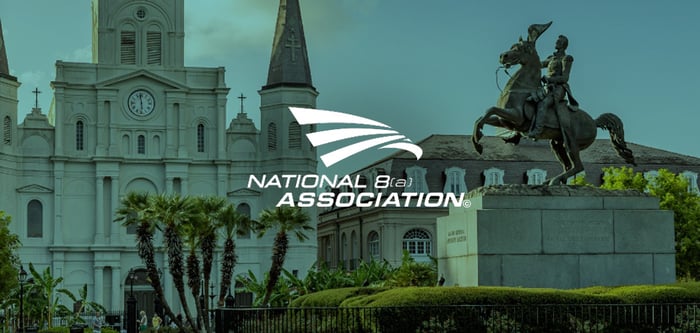2025 National 8(a) Small Business Conference recap
Explore key trends and challenges discussed at the National 8(a) Small Business Conference, including compliance, AI, and government contracting insights.

The annual National 8(a) Small Business Conference has long been a staple for small business owners and government contractors looking to expand their opportunities and better understand the complexities of federal contracting. This year’s event, however, had a unique backdrop—an exceptionally chaotic presidential transition period. With a flurry of executive orders (EOs) being passed, revoked, or altered, and sweeping changes to funding, compliance standards, and government operations, it’s safe to say this year’s attendees had plenty on their plates.
Despite the uncertainty lingering in the air, the overarching atmosphere was one of resilience and determination. Attendees and speakers alike embodied the "can-do" mindset that defines this community. The message was clear—no matter what the political tides bring, this group is ready to adapt, innovate, and thrive in ways that continue to strengthen the economy and national security.
Here’s a closer look at key themes, challenges, and takeaways from the 2024 National 8(a) Small Business Conference.
Key themes from the conference
While uncertainty dominated many conversations at the conference, several other critical themes emerged during presentations, booth discussions, and networking sessions.
AI takes center stage
Artificial intelligence (AI) became an even hotter topic than in previous years, driven by the need for organizations to streamline their operations, boost efficiency, and stay competitive. Three separate presentations on AI throughout the conference drew standing-room-only crowds, underscoring the urgency of this issue for businesses of all sizes.
A major focus was on how AI can help GovCons improve proposals and capture, automate compliance processes, and enhance performance analytics. Our own session on AI highlighted practical applications for small businesses to integrate AI into everyday workflows without breaking the bank. The sense of enthusiasm around adopting innovative AI tools was palpable and sparked lively discussions on both the opportunities and risks involved.
Takeaway for contractors:
If AI isn’t already part of your business strategy, it’s time to reconsider. Start small—invest in AI-powered tools for proposal writing or other text-heavy tasks—and scale as you grow comfortable with the technology.
Escalating compliance requirements
Anyone in the world of government contracting knows that compliance has always been a critical priority. This year, however, compliance took center stage in a way that felt impossible to ignore. Attendees buzzed with talk of the Cybersecurity Maturity Model Certification (CMMC) and its far-reaching implications.
For many, the upfront costs for compliance were a wake-up call. Implementing NIST SP 800–171 (rev2) controls comes with an estimated $152,000 price tag, while undergoing certification assessments costs another $105,000. Additionally, ongoing costs are expected to hover around $100,000 annually. With CMMC Level two already being written into federal and subcontracting contracts, and a final rule expected in the next few months, businesses have no time to lose in closing their compliance gaps.
Compliance requirements beyond cybersecurity also gained attention. Agencies allocating greater contract dollars to GWACs (Government-Wide Acquisition Contracts) and IDIQs (Indefinite Delivery Indefinite Quantity contracts) have necessitated stricter compliance measures. Standards like MMAS (Material Management and Accounting Systems), EVMS (Earned Value Management Systems), and accounting system certifications were emphasized heavily, especially during proposal evaluations.
Takeaway for contractors:
Budgeting for compliance is no longer optional. Small businesses need to set aside time and resources to meet these standards. With upfront costs, ongoing audits, and potential penalties for non-compliance, prioritizing this area early will save stress and money in the long run.
Fed employee and DOGE challenges impact contractors
Another recurring topic of conversation was the unexpected challenges faced by federal employees, and by extension contractors, during this transitional period. Contractors reported frequent frustrations contacting their federal customers, including government employees failing to show up for scheduled meetings and a noticeable number of empty exhibit booths set up on behalf of government agencies. There was also a lot of discussion about the Department of Government Efficiency (DOGE), how it was created, what impacts to contracts have already occurred, and what can be expected. There were a lot of rumors, and things were changing on a daily basis as has been covered extensively in the national media. Elon s
This was partly due to increased pressure on federal employees due to recent changes, such as DOGE activities and return-to-office (RTO) policies. Regardless of the reason, these issues posed logistical hurdles for small businesses looking for clear guidance or business opportunities.
Takeaway for contractors:
While federal employee challenges are largely out of a contractor’s control, building multiple strong relationships within agencies can help mitigate these frustrations. Engage key decision-makers through proactive communication efforts and stay persistent when navigating bureaucratic obstacles.
The spirit of resilience and determination
The main takeaway from this year’s National 8(a) Conference wasn’t just about the challenges—it was about the resilience that small business owners bring to the challenges they face. This is a group of entrepreneurs who regularly face complex funding structures, compliance headaches, and shifting federal priorities, yet they persist and evolve to meet every hurdle.
The mindset within the room made it clear that, while change is inevitable, the dedication to making their businesses—and, by extension, the country—better remains unwavering. From small steps like learning how to implement AI tools to massive lifts like achieving full CMMC compliance, the attendees of the 8(a) Conference are ready to take on whatever comes next.
Moving forward
If you’re a small business owner or GovCon, the insights from this year’s conference highlight one essential truth—adaptability is your greatest asset. Investing in technology, prioritizing compliance, and staying informed on federal changes are non-negotiable strategies for success moving forward.
Want to stay ahead of the curve? Consider subscribing to our newsletter, where we provide industry updates, compliance tips, and insider advice to help small businesses thrive in federal contracting. Together, we can face uncertainty and build stronger, more resilient businesses. Want to learn how Unanet can help? Schedule a demo today.